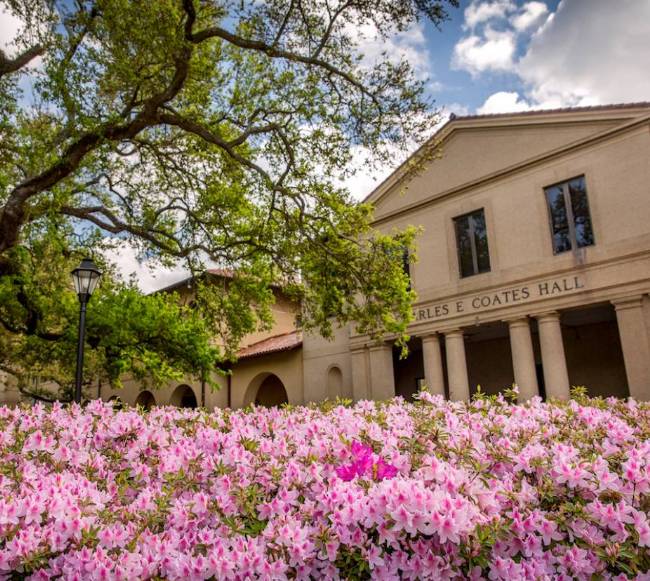LSU Engineering and French Student Relishes ‘Small Role in World Peace’ as Intern at Renowned Los Alamos Lab
July 09, 2024
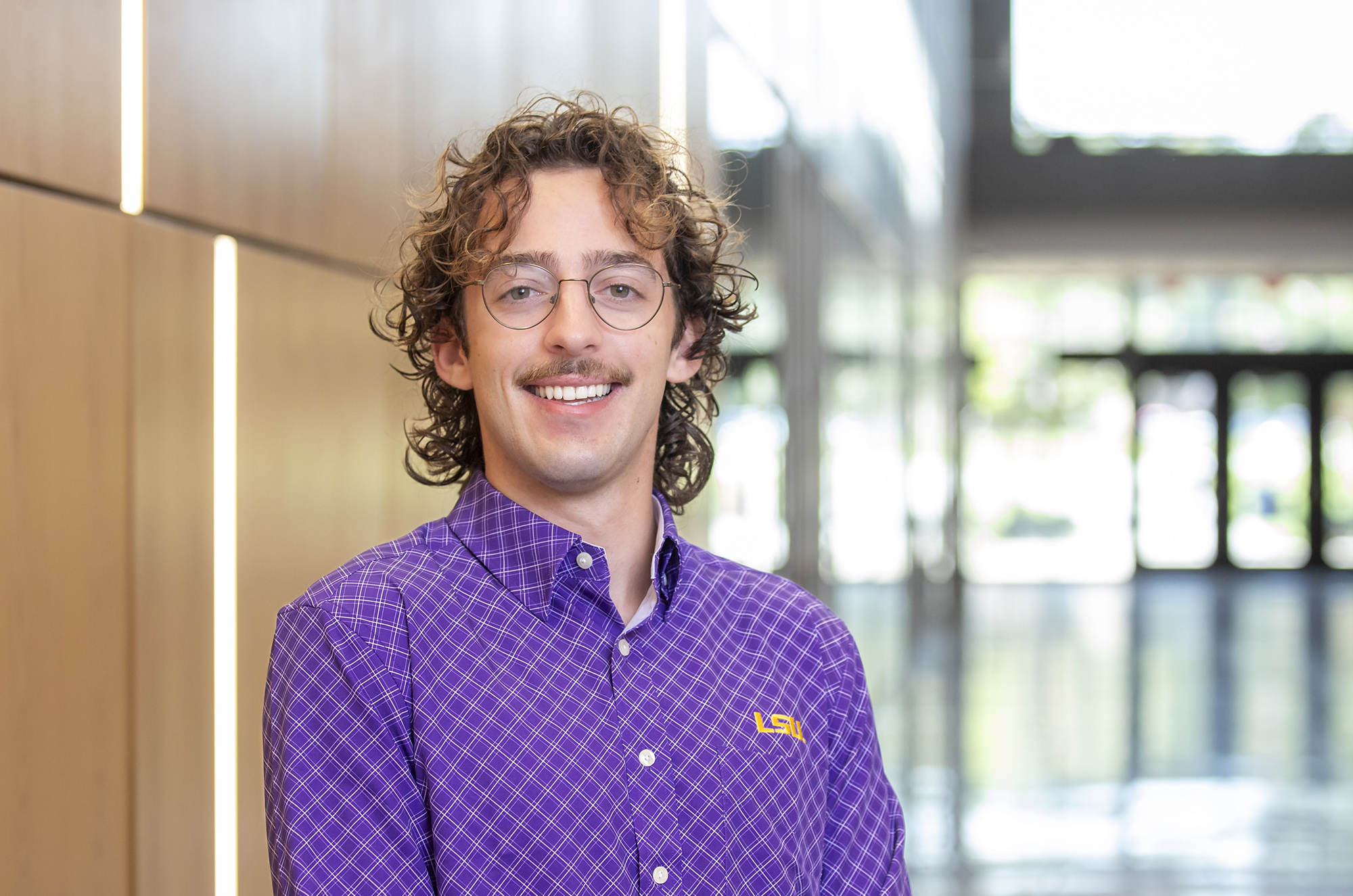
Reagan Courville
As much as Reagan Courville enjoys his mechanical engineering coursework at LSU, he admits that sometimes it can get a little taxing. That’s when he shifts to his other passion and unwinds with a little creative writing — in French.
It’s an odd combination, he admits, but somehow it works for him.
“A huge advantage of this is that I hardly ever feel truly burnt out. Whenever I get tired of my engineering coursework, I can always go work on a French paper, or vice versa.”
Courville’s academic path for the past four years has allowed him to pursue both engineering and French degrees at LSU. This summer, that path has taken him to the Los Alamos National Lab (LANL) in New Mexico to participate in the Department of Energy's Science Undergraduate Laboratory Internship program.
That’s THE Los Alamos National Laboratory, established in 1943 to conduct scientific research for the Manhattan Project, an allied effort that developed the world’s first atomic weapons.
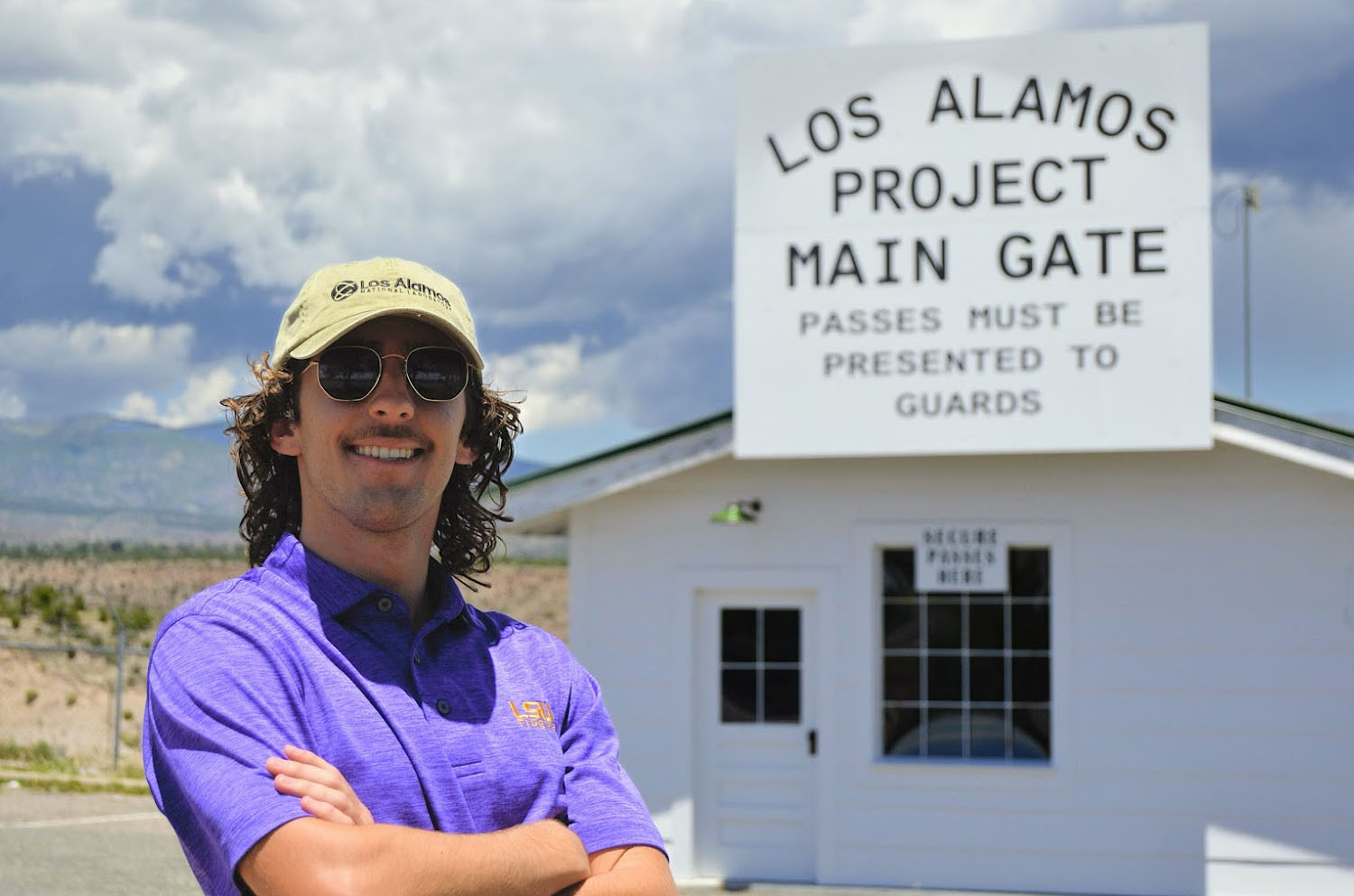
Reagan Courville visits a re-creation of the historic security gate all Manhattan Project workers passed through to enter Los Alamos.
– Photos provided by Reagan Courville
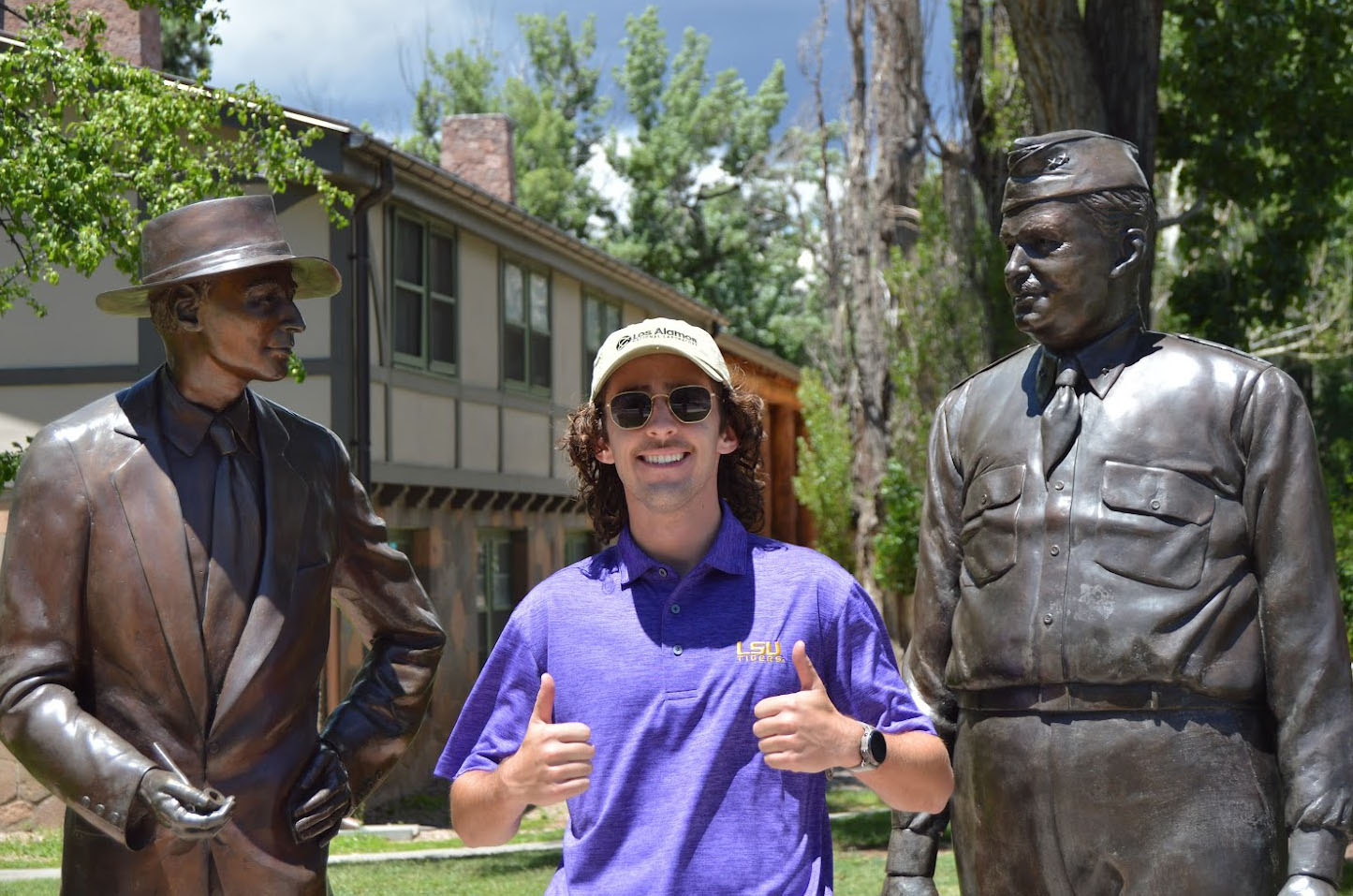
Reagan Courville with sculptures of Robert Oppenheimer, left, who oversaw development of the atomic bomb during the Manhattan Project, and Gen. Leslie R. Groves, the military leader of the project, in downtown Los Alamos, New Mexico.
Despite its origins, the lab now has a main mission of national security through nuclear deterrence and stockpile stewardship, Courville says.
“LANL has truly exceeded my expectations. The facilities are great; my mentor is very supportive and knowledgeable. Many feats of engineering have been accomplished at this lab,” he says. “The project I’m involved with plays an active role in maintaining the nonproliferation of nuclear weapons worldwide. That all said, it’s pretty awesome to play my oh-so-very small role in world peace.”
This summer, he will be working on a project to make it easier to measure the atomic makeup of radioactive samples, which would aid governments and nuclear authorities to better understand the risks and level of safety of a variety of radioactive materials in the field. In the scope of his 10-week summer internship, he will be assisting to improve the usability of an instrument to make these measurements as an alternative to the current heavy machinery traditionally used.
This alternative technology, called FABIA (Fieldable Atomic Beam Isotope Analyzer), just this last year received an R&D 100 award, which is often referred to as the “Oscars of Innovation.” The instrument will make surveying nuclear power sites and radiation-affected areas more efficient, aiding public safety measures and policy. Additionally, in collaboration with the International Atomic Energy Agency, this technology has the potential to be employed to maintain nuclear nonproliferation safeguards by holding countries accountable for their radioactive material production.
Courville on the Science Behind his Internship Work
“I will be working 40-hour weeks directly under my mentor, Dr. Alonso Castro, who will touch base with me daily,” Courville says. “My tasks will be somewhat varied from day to day, from CAD (Computer Aided Design) modeling to literature reviews to assembling to programming."
He’s hoping to return to LSU more skilled in applicable mechanical design and optimization.
“The project that I’ve been selected to work on this summer has a lot of parallels with the research I’ve been focusing on at LSU, dealing with laser diagnostic systems and instrumentation,” he says. “So naturally, I’d love to come back with more knowledge to apply to the on-campus lab I work for (the Energy and Propulsion Lab under Dr. Shyam Menon).”
Courville will also be returning to his French studies, a subject dear to him due to his family’s Acadiana roots. While Courville grew up in Baton Rouge, he remains close with family in Lafayette and visits often. That connection has driven his interest in French.
“French has always played a major role in my life,” he says. “I initially decided to pursue a formal education in French to connect even more with my grandparents, as they all speak Cajun French. Seeing that I’m the only grandchild with an academic background in French, I definitely earn some brownie points with the folks.”
That pursuit took an unexpected turn about a year ago, when Courville decided to enter an international literary competition through a Louisiana-based francophone publishing company called Les Éditions Tintamarre.
“I ended up writing a fictional short story in the style of a fairytale based on some childhood and old stories of my grandpa on his family’s farm. The story focuses on the relationship of Cajun culture with nature and agriculture,” he says. "Rather unexpectedly to me, the piece was rewarded first place with a cash prize and was included in a collection as a juried publication.”
That writing success inspired Courville to hone his skills as a francophone author, to one day expand his skills to French technical writing to publish scientific research, and to consider the option of working in a francophone area in the future.
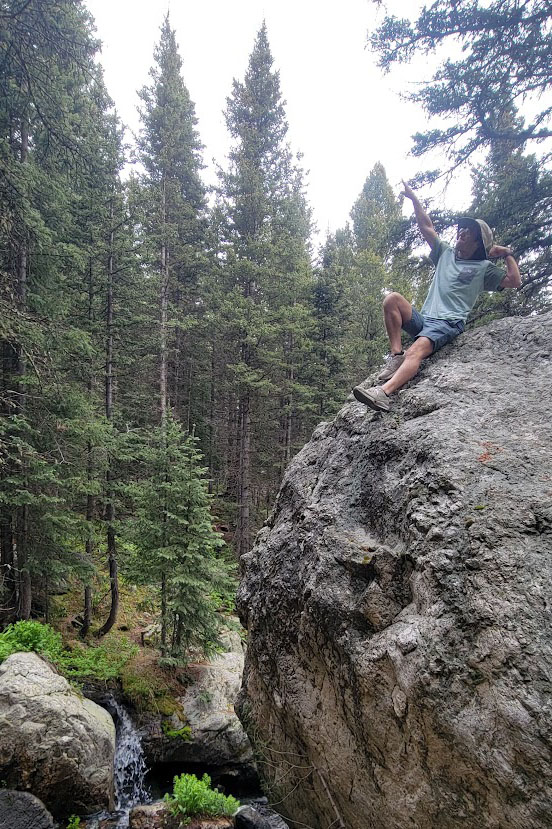
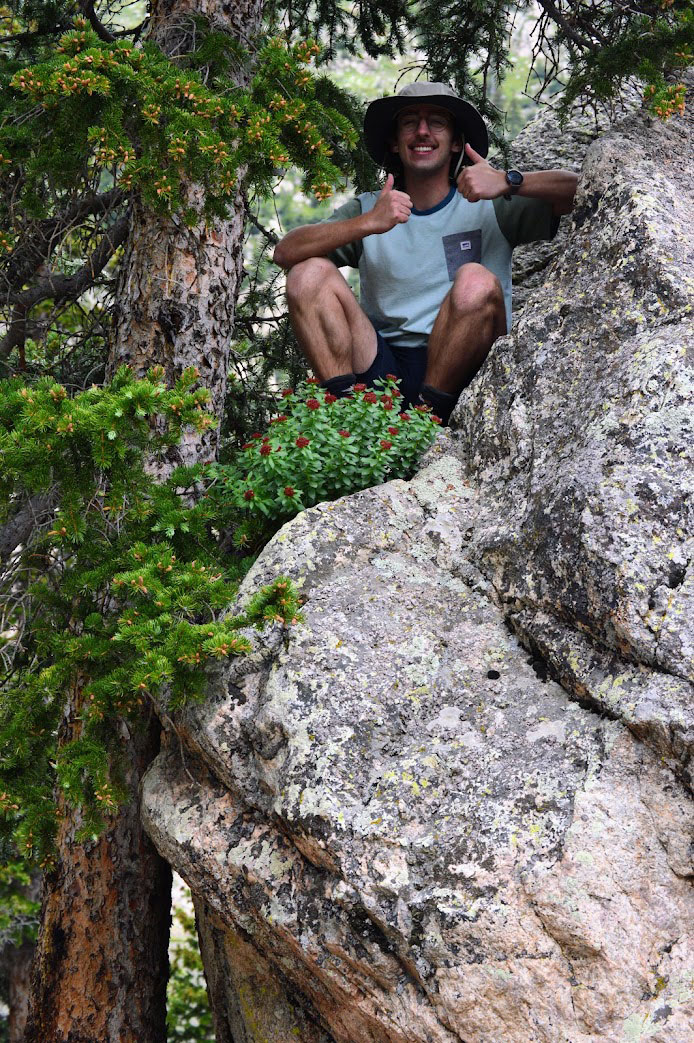
Ever adventuresome, Courville says the three-day weekends built in this summer’s internship allow plenty of time to explore northern New Mexico's unique attractions.
“The landscape up here is so gorgeous; I’m not sure I’ll get tired of it in the two months I’ll be here,” he says, noting that the area’s lack of city life is fine with him. He has made it known he would be packing camping gear, a telescope, and a banjo.
“I love to hike. Another popular activity out here is climbing, so I plan to get into that as well during my stay. Finally, with the whole lack of large light-polluting cities near me, the night sky of New Mexico is definitely a spectacle compared to Baton Rouge, at the very least. I have plans on doing a lot of camping and star-hunting while up here!”
As for that banjo: “I was gifted a banjo about six months ago, so I’ve been learning that for some time now,” he says. “It’s definitely an easy way to get my mind off school and learn a unique skill. Plus, there’s so much music history and so many stories behind genres like Bluegrass. It’s been a treat to delve into it all.”
“I would most likely not have been offered this position if it weren’t for my experience with laser diagnostic techniques in that lab at LSU.”
- Reagan Courville
Quick Takes
Courville on Why He Chose Mechanical Engineering
My initial interest in pursuing a degree in mechanical engineering was most definitely sparked by the prospects that the degree allows for. Out of all the engineerings, mechanical is the most versatile; with a background in mechanical, you can truly enter a myriad of industries. Along with this security, a vital requirement for me in choosing my degree program was the ability to leave my mark and innovate in some way. To me, a job in engineering is simply a job in innovation, so it really only seemed logical.
Courville on His Future Plans
I currently plan on entering aerospace research and possibly working in industry for some time. More specifically, my interests are mostly related to propulsion and space systems. In terms of schooling, I plan on pursuing more coursework in physics as well as specializing further in aerospace after LSU. With this opportunity, I will gain valuable experience in research and in mechanical design and assemblage. The program that I am participating in is known to be a great opportunity for early-career researchers in many areas of engineering and physics!
Courville on How He Came to Apply for the Internship
Last summer I worked as a part of the NASA Academy of 2023 at Langley Research Center along with 15 other students from around the US. My boss recommended that I look into opportunities at the DOE’s national labs as they offer a great deal of experience in research.
My time as an undergrad researcher under Dr. Menon very neatly equipped me with the skills to qualify me for this opportunity. I would most likely not have been offered this position if it weren’t for my experience with laser diagnostic techniques in that lab at LSU. Additionally, the physics classes and machine design courses I’ve taken at LSU have given me an adequate academic basis to understand the processes and design of the project at Los Alamos.
Courville on the Science Behind His Internship Work
Radiation comes in all sorts of different flavors. In a similar vein, so do radioactive materials. From the pit of a nuclear weapon to the radioactive debris of our environment, the effects of radioactive material on people and the Earth can be far-reaching and detrimental if not accounted for and understood. That said, having the capacity to analyze these materials allows scientists and authorities to make sound decisions when it comes to gauging their safety.
The current, most popular way to do this is to use a device called a mass spectrometer, which uses the physical properties of elements and isotopes to determine their composition. By understanding these elemental and isotopic signatures, scientists can identify the type and stage of the radioactive decay chain, allowing them to make conclusions about the safety and future of a radioactive material or of the environment.
A big issue with mass spectrometers is their size; due to the physics involved in the instrumentation itself, they are not very portable. In addition to the size limitations, mass spectrometers are susceptible to erroneous measurements due to undesirable atoms of similar masses; this requires samples to be thoroughly processed through a series of time-consuming preparation steps.
The project I’m involved with this summer seeks to solve both of these problems, using a different technique of determining the isotopic signatures of radioactive material called laser absorption spectroscopy. In short, the laser spectroscopy as performed by this instrument uses the optical interactions between a vaporized radioactive material and a laser beam to characterize the abundance of isotopes found in a given sample.
With this technology, scientists would be able to identify the isotopic composition of radioactive material more readily in the field without relying on heavy machinery traditionally used in this application.
Next Steps
Let LSU put you on a path to success! With 330+ undergraduate programs, 70 master's programs, and over 50 doctoral programs, we have a degree for you.
